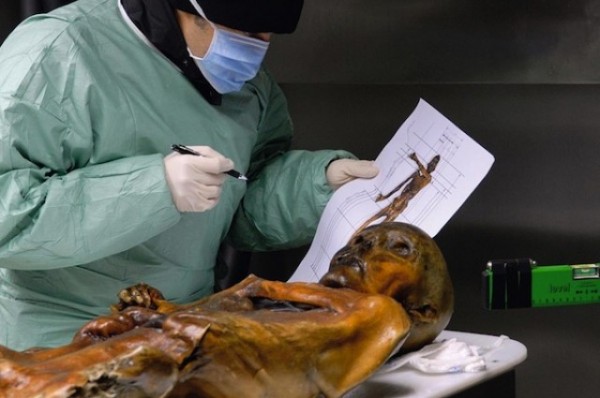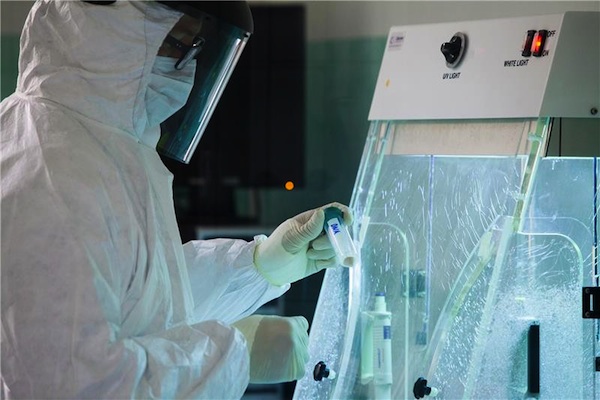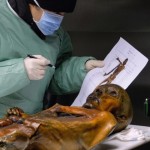
photo credit: South Tyrol Museum of Archaeology/Eurac/Samadelli/Staschitz
In 1991, hikers in the Ötztal Alps near the Italian-Austrian border stumbled upon what appeared to be a human corpse jutting out of the ice and meltwater. The body was extracted, and after exhaustive examination, researchers concluded that the glacier mummy was a 45-year-old male, about 1.6 meters (5 foot 3 inches) tall and weighing 50 kilograms (110 pounds). Analyses of his tissue samples and possessions — which included an axe, dagger, bow and arrows, a full set of clothing, and a first aid kit — indicate that he lived about 5,300 years ago in the Copper Age. He likely died from an arrowhead wound in his left shoulder. Ötzi the Iceman, as he came to be called, is house in the South Tyrol Museum of Archaeology in Italy.
A couple years ago, Ötzi’s genome was sequenced using a pelvic bone sample weighing just 0.1 grams. From this, we know that he was lactose intolerant and had type-O blood. Non-hominoid sequences were also detected with the mummified remains. These non-human reads are referred to as his “metagenome,” and it indicates the presence of microbes.
Now, a team led by Frank Maixner of EURAC Research in Italy reanalyzed the metagenomic data of the Iceman’s genomic survey (pictured below). They found evidence of a pathogen in the tissue biopsy. Called Treponema denticola, this opportunistic oral pathogen is involved in the development of periodontal (or gum) disease. Its sizeable presence was especially surprising: The pathogen had to have been distributed via the bloodstream from the mouth to the hip bone.
“This ‘non-human’ DNA mostly derives from bacteria normally living on and within our body. Only the interplay between certain bacteria or an imbalance within this bacterial community might cause certain diseases,” study coauthor Thomas Rattei from the University of Vienna explains in a news release “It is highly important to reconstruct and understand the bacterial community composition by analyzing this DNA mixture.”

According to the researchers, the bacteria didn’t colonize the body after death; they were part of Ötzi’s “commensal oral microflora” when he was alive. These findings confirm a CT-based diagnosis published last year showing that the Iceman suffered from periodontitis, an infection of the ligaments and bones that support teeth. It’s what happens when inflamed gums go unchecked.
The pathogen’s presence was further confirmed when the team analyzed gum tissue biopsy and a mouth swab sample taken from the Iceman. The work was published in PLoS ONE last month.
Images: South Tyrol Museum of Archaeology/Eurac/Samadelli/Staschitz (top) & Frank Maixner/EURAC (middle)








 Photographer Finds Locations Of 1960s Postcards To See How They Look Today, And The Difference Is Unbelievable
Photographer Finds Locations Of 1960s Postcards To See How They Look Today, And The Difference Is Unbelievable  Hij zet 3 IKEA kastjes tegen elkaar aan en maakt dit voor zijn vrouw…Wat een gaaf resultaat!!
Hij zet 3 IKEA kastjes tegen elkaar aan en maakt dit voor zijn vrouw…Wat een gaaf resultaat!!  Scientists Discover 512-Year-Old Shark, Which Would Be The Oldest Living Vertebrate On The Planet
Scientists Discover 512-Year-Old Shark, Which Would Be The Oldest Living Vertebrate On The Planet  Hus til salg er kun 22 kvadratmeter – men vent til du ser det indvendigt
Hus til salg er kun 22 kvadratmeter – men vent til du ser det indvendigt  Nearly Frozen Waves Captured On Camera By Nantucket Photographer
Nearly Frozen Waves Captured On Camera By Nantucket Photographer  It’s Official: Astronomers Have Discovered another Earth
It’s Official: Astronomers Have Discovered another Earth  Meteorite That Recently Fell in Somalia Turns Out to Contain Two Minerals Never Before Seen on Earth
Meteorite That Recently Fell in Somalia Turns Out to Contain Two Minerals Never Before Seen on Earth  Superknepet – så blir snuskiga ugnsformen som ny igen!
Superknepet – så blir snuskiga ugnsformen som ny igen! 